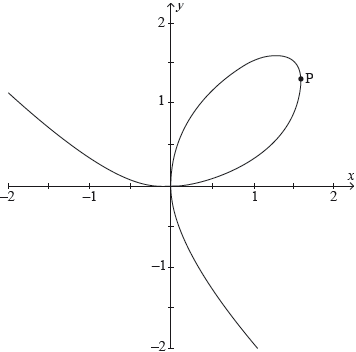| Date | May 2022 | Marks available | 2 | Reference code | 22M.1.SL.TZ2.11 |
| Level | Standard Level | Paper | Paper 1 | Time zone | Time zone 2 |
| Command term | Find | Question number | 11 | Adapted from | N/A |
Question
Consider the function .
Line is a tangent to at the point .
Find .
Use your answer to part (a) to find the gradient of .
Determine the number of lines parallel to that are tangent to . Justify your answer.
Markscheme
A1A1
Note: Award A1 for , A1 for OR
[2 marks]
attempt to substitute into their part (a) (M1)
A1
[2 marks]
EITHER
M1
A1
OR
sketch of with line M1
three points of intersection marked on this graph A1
(and it can be assumed no further intersections occur outside of this window)
THEN
there are two other tangent lines to that are parallel to A1
Note: The final A1 can be awarded provided two solutions other than are shown OR three points of intersection are marked on the graph.
Award M1A1A1 for an answer of “3 lines” where is considered to be parallel with itself (given guide definition of parallel lines), but only if working is shown.
[3 marks]
Examiners report
Was reasonably well done, with the stronger candidates able to handle a negative exponent appropriately when finding the derivative. There were a few who confused the notation for derivative with the notation for inverse.
Most knew to substitute into the derivative to find the gradient at that point, but some also tried to substitute the y-coordinate for .
There was a lot of difficulty understanding what approach would help them determine the number of tangents to that are parallel to L. Several wrote just an answer, which is not adequate when justification is required.


